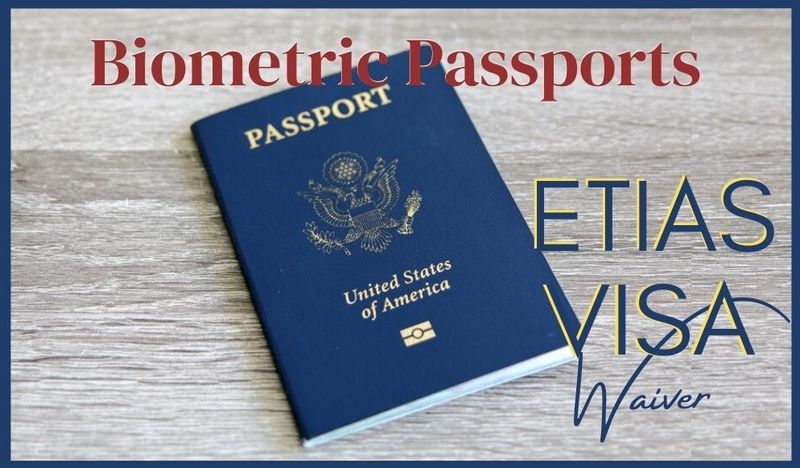Do I need a biometric passport for ETIAS?

- Posted on 06 Nov, 2020
- 0 866
Biometric passports change the way we travel
November 2020 - Many short-term travelers from around the globe are accustomed to traveling to Europe with just a passport. However, beginning in early 2023, citizens of 61 countries, including Canada and Japan, will be required to apply for travel authorization through the European Travel Information and Authorization System (ETIAS).
ETIAS is a completely digital process and will involve electronically tying your identification and travel information to your passport. The way to do this is through biometric passports, which will be required for the visa waiver program. Read on to learn more about biometric passports and ETIAS.
What is a biometric passport?
Biometric passports, sometimes called e-passports or digital passports, in many ways look like a traditional passport, but the biometric passport has added security features such as a microprocessor chip that contains information about your identity. This information includes:
- Photo ID
- Name
- Biographical information such as birthdate and birthplace
You will clearly see this information on the physical passport as well, but the information is also contained on the chip, meaning the information can quickly be scanned and held electronically.
The microprocessor also contains communications technology that allows for seamless data transmission. All of the additional security measures for biometric passports make them incredibly difficult to falsify and makes security screening easier.
What is ETIAS?
The European Travel Information and Authorization System or "ETIAS," is essentially a visa waiver that will allow easy entry and exit to any or all of the 26 countries in the Schengen area of Europe. Authorization through this system will be required for 61 countries.
The Schengen area is a region of Europe that is mostly comprised of European Union members but also includes associate countries, including Iceland, Monaco, and Norway.
This system has an online application process that will involve confirming your identity and performing a quick background check in order to identify potential security concerns. Authorization is valid for three years, and once you enter an external border you are free to travel anywhere within the region without the need for additional paperwork or security clearance. Visas will still be required for long-term travel (longer than 90 days).
How do I know if I have a biometric passport?
Most countries have switched to biometric passports at this point—as of 2017, 120 countries used biometrics. However, depending on when your country implemented these new passports may leave you wondering if yours qualifies.
For example, biometrics were adopted for US passports more than 10 years ago and passports are valid for 10 years. Therefore, all valid US passports are biometric.
However, the main way you can tell is through the internationally recognized e-passport symbol on the front of the passport, which looks like a small camera. This symbol is on all digital passports, regardless of country.
How do I obtain a biometric passport?
Each country has different passport requirements, and may have to request a biometric passport option if your country does not issue it by default. Depending on where you live, you may need the following:
- Citizenship documents (birth certificate, naturalization papers, etc.)
- Identification information (birthdate, birthplace, full name, family information, etc.)
- Photograph (might be physical, digital, or both)
- Biometric information (fingerprint, facial scan, etc.)
Why do I need a biometric passport with ETIAS?
The ETIAS Visa Waiver Program has two main goals: to secure the external Schengen Area borders through identifying potential risks, and to make travel to the region more efficient through electronic processing.
In an effort to save travelers time upon entry, citizens from 61 countries outside of the Schengen zone will be required to apply for pre-approval to travel to the region. This application process is online and requires a biometric passport. When your application has been approved, that information will then be digitally tied to the passport.
Upon arrival to any Schengen area country, you will present your passport (as you would have previously), and entry officials can quickly scan and confirm your travel authorization.
Schengen zone members will be able to maintain entry and exit records of all short-term travelers, which is not possible under the old system. Because everything is held through a single document—the digital passport—border processing should take significantly less time than before.
When will the ETIAS be effective?
ETIAS is currently scheduled to go into effect late 2022 with a six-month grace period that will give travelers more time to make arrangements. The application process is entirely online, and travelers must have a biometric passport. Applying is not expected to take long (approximately 20 minutes), but any inaccuracies can result in a rejected application.
The future of travel is here. Get ready for European adventures with a biometric passport.
The European Travel Information and Authorization System (ETIAS) will simplify the way we access the Schengen area of Europe. Learn more about Schengen zone countries and get travel updates by following our ETIAS blog.
